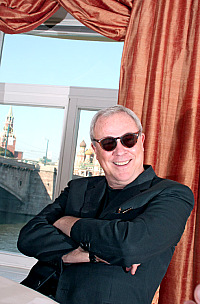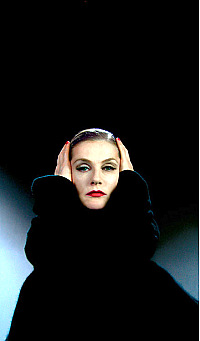Press room
"The Moscow Times. Context", October 5, 2007
Stripping Brad
Theater director Robert Wilson presents short video portraits that show acting stars in a strange new light.
By Alastair Gee
 Topless and perched on a swing, celebrity burlesque artist Dita Von Teese gazes into the distance with a rapturous expression on her face. She's wearing jewel-encrusted heels and sparkly tassles over her nipples. Suddenly she hears cheering. Her breathing seems to quicken, and her head slowly turns as if to drink up the praise.
Topless and perched on a swing, celebrity burlesque artist Dita Von Teese gazes into the distance with a rapturous expression on her face. She's wearing jewel-encrusted heels and sparkly tassles over her nipples. Suddenly she hears cheering. Her breathing seems to quicken, and her head slowly turns as if to drink up the praise.
Nearby, Brad Pitt is also in a state of undress. He's standing in the rain in sodden boxer shorts. Then the downpour stops. He raises a pistol to the camera and fires. Something like relief washes over his face.
These video portraits and 23 others -- allegorical, ambiguous and no more than a few minutes long -- went on display this week at the Yekaterina Cultural Foundation. The subjects are mostly actors or animals, including Johnny Depp, Winona Ryder, a snowy owl and a South American porcupine. They're part of a series by the renowned U.S. avant-garde theater director Robert Wilson, otherwise known for staging extremely long conceptual plays.
Many of the films are engaging, moving updates of the portrait genre, though a few use such extreme camera angles and perspectives -- the upside-down portrait of Marianne Faithfull, for example -- as to be unengaging.
Wilson said in an interview Saturday that the portraits are united by a theme that has dominated his theater work since his first plays in the 1960s: stillness. While the subjects of the films vary dramatically, from French actress Jeanne Moreau playing the role of Mary, Queen of Scots, to ballet dancer Mikhail Baryshnikov as St. Sebastian, the sitters rarely make more than a single, symbolic gesture.
"The portraits change like the time of nature," Wilson said. "The time it takes for a cloud to pass by, or to see the movement of a tree, or the light of a day, how it changes."
Moreau as the queen, tense and gaunt, simply looks around the darkened room she's sitting in, perhaps reflecting on all the mistakes that have led to her execution. Baryshnikov, tied to a column and impaled by an arrow, takes almost imperceptible breaths.
Born in the provincial town of Waco, Texas, in 1941, Wilson, who is gay and had a speech impediment in his childhood, struggled with depression and even attempted suicide before a liberating move to New York in 1963.
He began making experimental productions characterized by slow movement, sparse dialogue and the repetition of scenes. Directing the five-hour 1976 opera "Einstein on the Beach" brought him international recognition, and he went on to make the 12-hour play "The Life and Times of Joseph Stalin" and "KA MOUNTain and GUARDenia Terrace," a play that was staged on a mountain in Iran over the course of a week.
Wilson began taping the video portraits in 2004 in partnership with Voom, a U.S. cable television channel. The ideas for some portraits were formulated after lengthy discussions, while others were thought up on the morning of the shoot. It took about three hours to film each one.
 |
There was little diva behavior on set, Wilson said.
Johnny Depp, who's shown wrapped in a feather boa, was very obliging, he noted. And "Brad was real easy -- he's a sweetheart. ... I asked him, 'Would you mind doing it nude?' He said, 'Oh, maybe, but can I wear my socks because my feet are so ugly?'"
Sean Penn, however, who is himself a director, was very vocal about what he thought would and wouldn't work. "I think basically maybe he's insecure," Wilson suggested.
Often the portraits are inspired by artworks relevant to the sitter. Princess Caroline of Hanover's hands are posed like the hands of her mother, Grace Kelly, in a scene in "Rear Window." Meanwhile, actor Robert Downey Jr., who has publicly acknowledged a battle with drug addiction, is shown as a corpse at an autopsy, imitating a painting by Rembrandt. His arm is flayed open, and a doctor is pointing to a vein where heroin might be injected.
Filming proved challenging or emotional for some sitters, including the self-styled Empress of Iran, Farah Pahlavi, the widow of the late, deposed Shah of Iran.
Wilson's portrait, she suggested, had captured her essence.
"She said, 'What am I supposed to think?' And I said, 'Think nothing.' And she said, 'I can't do that,' so I said 'OK, think anything you want,'" Wilson recalled.
"And she's sitting at a glass table that's lit in a strange way, and she takes her arm to her head and holds it for a long time and then takes it down. And it took us about four or five hours to shoot this portrait. It was very moving to see her do this.
"And afterward, when she saw it, she started crying. She said, 'All my life is there.'"
"VOOM. Portraits by Robert Wilson" runs to Nov. 11 at Yekaterina Cultural Foundation, located at 21 Kuznetsky ost. Metro Kuznetsky Most.
